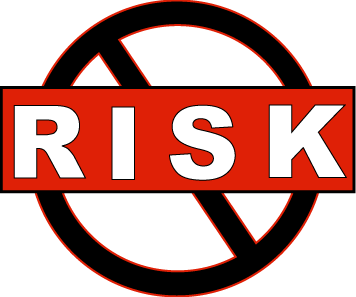Jill Konrath's Blog, page 29
June 19, 2013
5 Strategies to Eliminate the 'Perceived Risk' Sales Objection
 Nobody wants to make a bad decision. People don't like the unknown; they fear it. They're leery about making any change when there's the possibility of a career-derailing failure.
Nobody wants to make a bad decision. People don't like the unknown; they fear it. They're leery about making any change when there's the possibility of a career-derailing failure.
Your prospect's perceived risk can quickly turn into a sales objection. In order to prevent that from happening, you need to make them feel like they're in good hands.
Here are 5 strategies you can use to reduce your prospect's perceived risk in doing business with you or your company:
1. Leverage qualitative data. The more data you can have that supports your proposal, the better. Internal documentation (case studies, assessments) should be combined with external sources of validation. If at all possible, share relevant analyst's reports, studies, and articles.
2. Ensure transparency. Today's prospects want to know the truth, so don't shade it. In this social media age, where customers freely voice their opinions online, you can be assured that any issue about your offering, customer service, and financial stability can easily be uncovered.
3. Manage their expectations. Marketing strategist Kristine Maveus-Evenson says, "If both of you are clear about objectives, milestones, budget, scope of work, deliverables, and times lines, this builds trust. If you discuss this from the onset, it eliminates the FUD [fear, uncertainty, and doubt], which helps to mitigate their perception of risk."
4. Engage multiple stakeholders. Prior to any proposal or presentation, talk with all the people involved. Consultant Jeff Garrison recommends talking to them for at least fifteen minutes to getting their perspectives. This reduces the risk that your primary contact will be blindsided by turf issues or hidden agendas at the end of the decision-making process.
5. Offer references. Your willingness to openly share references with prospects makes a big difference. Certainly, you have your top clients who love you. But also consider offering your three newest customers, because they're most likely to relate to your prospects fears. Also, because they've just chosen you, they are likely to be strong advocates.
When your prospects are selecting which company they'll work with, certainty is a crucial factor. Unless they feel confident they're making a solid business decision, one that will help them achieve their business objectives, they'll stay with what they have. It's just plain easier - and certainly less scary.
If you ignore your prospects' fears, they won't go away. Instead, they'll lurk silently under the surface, wreaking havoc with their nerves, until your prospects finally decide that changing now isn't best for them - even if it is.






June 18, 2013
Get a Sales Leadership MBA in One Day
 Join me at the Inside Sales Virtual Sales Summit on June 20th. I’m joining forces with some of the world’s top sales experts to put on this FREE conference.
Join me at the Inside Sales Virtual Sales Summit on June 20th. I’m joining forces with some of the world’s top sales experts to put on this FREE conference.
Here is a sampling of the topics that will be covered:
Create Predictable, Scalable Sales Revenue
Best Practices of Sales Analytics
Winning the Changing Sales Game (me)
Building a Social Selling Culture
The Path to a Killer Marketing Strategy
It’s shaping up to be the biggest online event of the year for the sales industry. And you can attend all of the value-packed sessions at no cost.
Find out more and register online at http://www.insidesales.com/summit/register-speaker?a=ivs332
Whether you’d like to figure out how to generate more qualified leads, how to inspire and motivate your team, or how to use data more effectively, you’ll find answers from the top minds in sales at the Inside Sales Virtual Summit.
P.S. Yes, it’s being recorded. If you miss it, you can listen in later — when it fits your schedule.






June 17, 2013
Perceived Business Risks Quickly Become Sales Objections
 I'll never forget my meeting with the VP of Sales for a hot telecom company. They'd loved my proposal, so I figured we were getting together to kick off the project.
I'll never forget my meeting with the VP of Sales for a hot telecom company. They'd loved my proposal, so I figured we were getting together to kick off the project.
"I'm afraid I have bad news for you," the VP said. "We think your training program is superior to the other ones we've looked at. Your pricing is fair. And your ability to tie it in with our new product launch is unsurpassed. However, we've decided to go with your competitor."
My jaw dropped. I stared at him in shock. Then he continued, "If you get hit by a Mack truck, our entire training investment is gonzo. We just can't do that."
In short, he meant that my company was too small to do business with. Working with me entailed more risk than he was willing to take.
That was the day when the concept of "risk" truly hit home for me. Our prospects deal with it all the time. But often we, as sellers, are totally blind to what a risky decision we can be.
In today's business environment, we have to be aligned not only with our prospects' business objectives, but also their risk temperament.
To your prospects, risk means the cost of making a mistake. It could be financial, social, psychological, or even emotional. Risk is about fear of change.
Chris Mercer, CEO of Mercer Appraisal, found this out early in the life of his company: "When we were smaller, we realized that there's a concept called 'safety' in the minds of most buyers. From their perspective, it's a multi-variable function of size, longevity, customer list, perceived quality, external affirmations (speeches, articles, books), and many other things. We've been working for more than twenty-five years to be the safe choice in our field."
That's what we all need to do. But it all starts with identifying what your prospects perceive as risky. Here is a list of just a few things they could fret over:
Projects not delivering results;
Losing money; missed deadlines;
Your company's financial solvency;
Cultural fit; compatibility;
Quality of your work;
If your expertise is right for them;
Accuracy of claims;
Your length of time in business;
If you're too big to care about their business; and
If you're too small to handle their account.
You may pooh-pooh some of these as no big deals, but believe me, I never thought a Mack truck would impact my ability to get business, either.






June 14, 2013
Three Ways to Make Repeat Sales
Today's post from the Chamber of Commerce features business-growth advice for small companies.

Making a sale is always a challenge. Whether a cold call or a follow up on a referral, closing a deal takes strategy and intuition to client needs. When that is rewarded with success, a sales high takes over – if only momentarily.
Once the endorphins wear off, there is still work to be done. After you’ve made that first sale, how do you turn a one-time buyer into a long-term client? Or in the case of a contract agreement, how do you ensure a renewal when the original term ends?
While every company may have its own specific follow-up policies in place, here are a 3 tried-and-true ways to keep clients coming back:
1. Follow through on promises. Make sure you deliver when you say you will. This is just good business but is often overlooked once transactions are complete. Prove that you are worthy of a long-term partnership by honoring your commitments. Of course circumstances may arise that are beyond your control, but ensure you aren’t the reason a product or service is delayed in its delivery to a new client.
2. Continue to woo them. In an interview on this blog, sales consultant Nancy Bleeke says preparation is one key to conversations that sell. Finding answers for prospective buyers BEFORE they ask will help them see the value in what you offer. That idea extends beyond the initial conversation though.
You should always have the needs of your client base at the forefront of your mind. Ask how a particular service or product is working out and listen to any concerns that arise. Don’t wait longer than a few hours to return a call or email. Show them that they are still valuable to you, even when the sale is complete.
3. Stay in touch. Don’t just wait for a phone call or make yourself a mental note to check in with a client at some point. Make a schedule for following up and stick to it. Personal emails or calls are best, but if that is unmanageable due to your number of clients, consider a monthly e-newsletter. Keep yourself and your company in the front of your clients’ minds so that they don’t hesitate to reach out the next time they need what you sell.
When it comes to sales, repeat customers are the sustaining factor in business revenue. Don’t just chase after new clients. Take the time to cultivate sales relationships and make it a key to long-term sales success.
How do you keep your clients coming back?
Katie Parsons writes for ChamberofCommerce.com where she specializes in business news affecting major markets. ChamberofCommerce.com helps small businesses with online growth. Plus, it facilitates connectivity between local firms and over 7,000 Chambers worldwide.






June 12, 2013
[Video] Do These Things Before Your Online Business Meeting
If you're not doing online business meetings yet, you will be shortly. They're great for initial meetings, in-depth discussions, demos, presentations and more. Here are some things to consider to make sure you come across as a real pro.
Let’s start with what to do before the business meeting. First, make sure that what people see on the screen looks decent. Clean up your desk, eliminate any clutter and turn up the lights. Also, think about what you’re going to wear. Seriously. Dress as if you’re actually meeting in person. But make sure to avoid bright colors or gaudy patters.
Then, make sure you do some dry runs. If this technology is new to you, practicing ahead of time will ease your angst. I’d suggest that you corner a colleague who can give you feedback on your professional image, body language and even an irritating habits you might have. Personally, I work from a laptop, so I put a couple books under it so that it’s at eye level and I can look straight into the camera.
Speaking of that, make sure you drag the other person’s video window right up under the camera. It’s critical to maintain good eye contact. And, if they’re in your lower left screen, that’s where you’ll be looking. That’s not the best way to establish a good relationship.
And finally, put as much time and effort into planning an online business meeting as you would an in-person one. Check attendees out on LinkedIn. Pull together an agenda. Write down the questions you want to ask.
Taking these steps will make a huge difference in the success of your online business meeting.







June 10, 2013
[Video] 4 Tips for a Successful Video Business Meeting
It’s often a lot easier to set up a video business meeting than an in-person one. Your prospects often prefer them because it gives them an opportunity to determine if it’s worth taking their valuable time to continue the conversation.
That’s why it’s important to make sure that it goes really well. Here are a 4 tips to ensure you have a successful video business meeting.
Eliminate distractions. The first thing you need to do is eliminate any potential distractions. That means you need to shut down email and text messaging. Put a sign on your door that says, “Do Not Interrupt”. And, make sure you don’t have anything that’ll tempt you to start multi-tasking.
Build rapport. Make sure you start the meeting with a few minutes of friendly chitchat to create a personal connection. When everyone has logged on, if you called the meeting, it’s your job to review the purpose of the meeting and double check time frames.
Lead the conversation. Then, you need to plan on leading the conversation because the best virtual meetings are highly interactive. They’re not one-way presentations. Have some questions planned to get people talking. And, make sure to draw out any silent attendees. Before you end the meeting, make sure you’ve agreed on the next step.
Record the session. You can send it to your prospect as a way of following up. You can also send it to others who couldn’t make the meeting. And, last but not least, you can review it to find ways you can personally improve.







June 7, 2013
Build a Highly Targeted Prospect List Using LinkedIn
 Stuart Armstrong faced a big challenge. He needed to get his company into as many decisions as humanly possible -- and he was starting from scratch. Below you'll read how he used LinkedIn to jumpstart his prospecting initiative.
Stuart Armstrong faced a big challenge. He needed to get his company into as many decisions as humanly possible -- and he was starting from scratch. Below you'll read how he used LinkedIn to jumpstart his prospecting initiative.
But first, a datapoint from Cracking the LinkedIn Sales Code, which highlights our 2013 Sales & LinkedIn Survey results.
As you can see from the graphic below, top sellers used LinkedIn 3X more than everyone else for building a highly targeted prospect list.
Clearly top sellers use LinkedIn fundamentally different from their colleagues. (Get the full survey results here.) And, to show you just what can be done, here's Stuart Armstrong's story.
___________________
We sell $400,000 to $2 million operating systems software primarily to North American telecommunications companies. My goal is to assure these companies consider us when their buying cycle starts. To make this happen, I leveraged LinkedIn as well as several other key resources.
Challenge: Within 45 days, starting from scratch, I built a prospect list of North American telecoms, cell phone and cable companies that have more than 200,000 subscribers (about $150MM sales) from a total cohort of 1200 companies. My objectives were twofold:
To quickly determine if there were pending deals we were unaware of. Since only CFOs could approve these deals, that’s where we focused.
To implement best Sales 2.0 business development and lead generation practices, enabling a future flow of opportunities. We wanted to identify and begin communicating with the ecosystem of decision makers, stakeholders and influencers.
I started by building a global prospect list merging data I’d gathered from Jigsaw, InfoUSA/Canada, Wikipedia, and associations. After that I pre-sorted and deduped the information and got my prospect list down to about 250 companies.
Next, I used InsideView and my LinkedIn connections to identify the correct people to contact in these companies. I also used InsideView to track trigger events and competitive intelligence about these companies, looking for things that could create potential opportunities for our services.
Process: Based on this research, I narrowed my list down to 60 high probability prospects who met my minimum ideal customer profile. Then, I dug into LinkedIn again.
I visited the profiles of many people in each company to identify decision makers and influencers in finance. I found between 5-20 people per account.
I monitored who visited my profile and verified this traffic on our website. And, I connected with as many of these people as possible so I had access to their second level connections. Plus, I made sure they could see my groups and the link to the website.
I used LinkedIn and other services to get the contact info for the CFOs of these 60 HP prospects.
Then I wrote an email focused on our value and thought leadership. After finalizing the message, I contacted the personal assistants of each of these CFOs, letting them know I’d be sending them an email with insight into recent revenue assurance and fraud issues.
This was just the start of my campaign, which includes at least seven contacts.
Outcome: Leveraging my LinkedIn contacts to build a prospect list is already yielding results. Many high-level executives have initiated a conversation with me or referred me to the right people in their organization.






June 4, 2013
Example of a LinkedIn Strategy That Gets Big Payoffs
 While selling for a growing technology company, Jill Rowley embraced "social selling" via LinkedIn, Twitter and more with a vengeance! Check out her LinkedIn strategies below to see why she is consistently a top salesperson.
While selling for a growing technology company, Jill Rowley embraced "social selling" via LinkedIn, Twitter and more with a vengeance! Check out her LinkedIn strategies below to see why she is consistently a top salesperson.
Here's a little food for thought first. In our 2013 Sales/LinkedIn research, we found that top sellers share relevant content much more that their counterparts.
If you break these numbers down further, 20.3% of top sellers ALWAYS shared content versus only 6.4% of everyone else. (Get Cracking the LinkedIn Sales Code now to discover what else top sellers are doing. The research may surprise you!)
___________________
To me, selling is all about relationships, building trust and establishing rapport. That’s why and how I use LinkedIn. And it all starts with your profile. It has to be created with your buyer in mind. Most salespeople don’t realize that.
My headline showcases that I’m a team player and major contributor. I have eleven recommendations. On my profile, I post presentations that are relevant to my buyers, such as case studies and analyst reports. I link to our company blog so that everyone can see our thought leadership content.
I see myself as an information concierge. I constantly look for good information that my prospects and customers would want to read – and share it with them via updates and Tweeting.
In my sales, I’m very targeted and strategic. LinkedIn helps me find the right people at the right companies. Using the advanced search function, I’ll enter in the company name, marketing titles, then keywords like automation, operations, and web. I use what I call a “surround strategy” – meaning I want to identify a number of folks in the organization that would be involved in our decision. I never want to be “single threaded” and just have one contact.
And, I surround my prospects on multiple channels too. I invite them to connect on LinkedIn. I follow them on Twitter. I retweet their tweets. I add them to my Google+ circle. I check them out on SlideShare. I want to know them intimately.
I’m always thinking, “How can I leverage my network too?” I’ll even check out the University of Virginia Alumni group on LinkedIn to see if I can find a person who can help me connect with a targeted decision maker. It’s been extremely effective.
When I reach out to people, I say something personal right away so I can create an immediate connection. I study people’s profiles carefully to find out what’s important to them professionally and personally. After doing that, I send them a message via LinkedIn with a connection request.
Each message is personally crafted to show I’ve done my homework. For example, I might start: “Wahoowa (our school battle cry)! Please allow me to use our UVA connection to e-meet you. I received a BS in Commerce in 1994.” Then, I’ll go on to mention:
Something about their profile/accomplishments I found interesting or relevant.
Names of mutual acquaintances or interests.
What my company does – but focus on the issues or business goals we help companies with. (It’s never, ever a product pitch.)
Several other companies we’ve worked with so they know we’re a credible resource.
Finally, I’ll close by asking if we can connect briefly to explore if our company is a good fit for their needs.
This approach has been highly effective in starting conversations. It gets me in the door, positioned as a valuable resource. But it’s not for salespeople who are looking for shortcuts and quick sales. It takes time to do the research and create personal messages. And, I want to be seen as a trusted advisor and expert in my area.
It’s a long-term strategy that's led to lots of business already, so I know it pays off big-time. I’ve been a top rep for many years now. And, in 2011, I was even named the Employee of the Year.






May 29, 2013
Top Seller LinkedIn Strategies
 LinkedIn can have a huge impact on sales success. However, that success depends on how you use it.
LinkedIn can have a huge impact on sales success. However, that success depends on how you use it.
In this 20 minute audio, Jill Konrath is interviewed by Michelle Davidson, editor of RainToday.com, about some of the most fascinating differences between how top sellers leverage LinkedIn vs. everyone else.
Listen to the audio to discover:
The LinkedIn capabilities top sellers value most.
How top sellers use LinkedIn to become invaluable business resources.
Ways top sellers leverage LinkedIn to differentiate from the competition.
How much time you need to invest to experience similar results.
LinkedIn matters. Don’t get left behind.
Get your copy of the audio file now:
www.jillkonrath.com/top-seller-LinkedIn-strategies






May 22, 2013
[Video] 3 Doable Strategies to Increase Sales Productivity
If you're like everyone else these days, you're overwhelmed with way too much to do and not nearly enough time to get it done. One of our biggest problems though is something we can control.
Being online much of the day isn't good for us. We bounce from task to task. We take emails when they come in. We make calls, visit websites, read articles, and do email again. And, sometimes we even get sucked into doing other things -- perhaps like even watching this video right now.
If you want to increase sales productivity and get much more done, here are a couple strategies to improve time management skills:
Block your time out. Devote an hour to just making calls -- or an hour to just get the proposal done. Don't allow any interruptions during that time.
Don't do your email first thing in the morning. You'll get totally sucked in and before you know it, the morning is gone. Instead, give yourself 2 times a day to do email. And stick to it. Your customers don't need you to be available 24x7.
And finally, spend 15 minutes at the end of the day planning what you'll start working on first thing tomorrow. That way, when you get to your office, you'll be all set to go.
What I'm suggesting is something you're totally capable of doing -- and, when you do, you'll have a lot more free time!






Jill Konrath's Blog
- Jill Konrath's profile
- 28 followers




